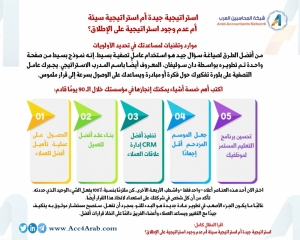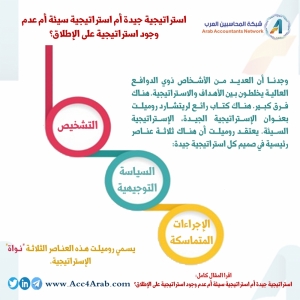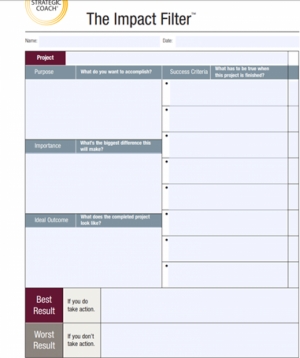عرض العناصر حسب علامة : عامل التصفية
الثلاثاء, 24 مايو 2022 07:41
إنفوجرافيك.. أهم خمسة أشياء يمكنك إنجازها في مؤسستك خلال ال 90 يوما القادمة
نشر في
إنفوجرافيك
موسومة تحت
الإثنين, 27 سبتمبر 2021 12:44
إنفوجرافيك.. ثلاثة عناصر رئيسية في صميم كل استراتيجية جيدة
نشر في
إنفوجرافيك
موسومة تحت
الأربعاء, 21 سبتمبر 2022 12:17
استراتيجية جيدة أم استراتيجية سيئة أم عدم وجود استراتيجية على الإطلاق؟
كان جاك ويلش، رئيس شركة جنرال إلكتريك الأسطوري، يحب أن يقول، "إن الخطوة الأولى لجعل إستراتيجية حقيقية هي الاكتشاف"
معلومات إضافية
-
المحتوى بالإنجليزية
2021: Good strategy, bad strategy or no strategy at all?
By Kyle Walters
January 12, 2021, 11:12 a.m. EST
4 Min Read
Facebook
Twitter
LinkedIn
Email
Show more sharing options
Legendary GE chairman Jack Welch liked to say, “The first step to making a strategy real is figuring out the big ‘Aha!’ that gives you sustainable competitive advantage.” Following that logic, Welch said: “If you don’t have a sustainable competitive advantage, then don’t [try to] compete.”
I know what you’re thinking: “Our firm is doing well, but I don’t know if we really have a sustainable competitive advantage.” Actually, you do have a competitive advantage: It’s called your relationship with your clients. And if you’re thinking to yourself: “Geez, now I have to develop a strategy on top of getting through busy season,” that’s actually a good thing. It puts you ahead of most of your peers.
I’ve found that many highly motivated people confuse goals with strategy. There’s a big difference. There’s a great book by Richard Rumelt called Good Strategy, Bad Strategy. Rumelt believes there are three key elements at the core of every good strategy:
1. The diagnosis;
2. The guiding policy;
3. The coherent actions.
Managing Your Firm in a Post-COVID World
Think beyond the pandemic with exclusive resources to help you build a thriving virtual practice.
SPONSORED BY INTUIT ACCOUNTANTS
Rumelt calls those three elements the “kernel” of a strategy. Let’s take them one at a time.
Step 1: The diagnosis. Like most people, many CPAs have a hard time simplifying all the complexity in their lives. It could be figuring out how to bring in great people to their firms, or improving their systems and processes. or getting better at marketing. Well, you can’t solve tough problems unless you diagnose them properly.
Charles Kettering, the iconic former head of research for General Motors liked to say, “A problem well stated is [already] half solved.” Using an "Impact Filter", which I discuss later in this article, can be a great, simple tool for helping you ask the right questions.
Step 2: The guiding policy. After diagnosing the problem, the next step is figuring out how you are going to deal with it. What’s your overall approach? What’s your big-picture plan? January is when most people, full of hope, talk about all the things they’re going to accomplish in the year ahead. Unfortunately, just talking about what you’re going to do is not going to move the ball down the field. Instead, you must be very intentional about how you plan to use your firm’s resources.
You only have so many resources — time, money and people — to go around. A truly coherent strategy forces you to pull resources toward areas of higher expected return and away from areas of lower expected return. You can’t allocate all your resources to every single initiative on your list. If you do, you’ll find yourself spread too thin and not making progress on anything.
Sound familiar?
Step 3: The coherent actions. According to Rumelt, these are the clear steps that need to be coordinated to carry out your guiding policy (see Step 2 above). In other words, identify what needs to be done, by whom and by when to implement your strategy.
Famed Silicon Valley venture capitalist Peter Thiel believes that with the right strategy in place, you can reach your 10-year goals in just six months. You don’t have to be a high-flying tech firm or a pharma company developing a COVID vaccine to accomplish this. You just need to determine the areas of your business that you need to be accelerated ASAP — and then allocate the necessary resources to support those areas.
What I learned the hard way
When I started my firm, I was full of boundless energy. I thought I had really solid 10-year goals and enough energy to tackle every opportunity that came my way. I learned over time that I did not have a coherent strategy. I did not have a kernel, as Rumelt would say. I simply had aspirations such as growing 10 percent each year, making three great new hires a year, or providing best-in-class client service.
Great ambitions, but I wasn’t thinking carefully about how many additional resources I’d need to deploy to reach those goals. I wasn’t thinking about where I’d have to sacrifice resources from other areas.
Resources and techniques to help you prioritize
One of the best ways to formulate a well-asked question is to use a simple Impact Filter. It’s a simple one-page form developed by Dan Sullivan, a.k.a. The Strategic Coach. The filter forces you to crystallize your thinking about an idea or initiative and helps you arrive quickly at a tangible go/no-go decision. If nothing else, the Impact Filter will prevent you from meandering and wasting precious time and resources.
90 Day Rocks, pioneered by EOS Software, are great for prioritizing your goals and resources — and for measuring your progress as you pursue them. Write down the top five things you could accomplish at your firm over the next 90 days:
1. Having a better client onboarding process;
2. Building a better client portal/vault;
3. Implementing a better CRM;
4. Just making April less stressful;
5. Improve your staff’s continuing education program.
Now pick one of those items above — just one — and cross off the other four. Be 100-percent committed to doing the one thing you selected. Make sure everyone at your firm is onboard with that decision, too.
Often the hardest part about developing a new habit is just getting started. Once you do, you’ll become a bona fide Anti-Fragile CPA before you know it — a trusted advisor who adapts well to change and who always helps clients and team members make better decisions.
Talk about a competitive advantage!
نشر في
موضوعات متنوعة
موسومة تحت
الثلاثاء, 09 فبراير 2021 11:43
30 دقيقة من وقتك يمكن أن توفر لك 30 يومًا من العمل
معلومات إضافية
-
المحتوى بالإنجليزية
30 minutes of your time could save you 30 days of work
By Kyle Walters
June 11, 2019, 3:58 p.m. EDT
5 Min Read
Facebook
Twitter
LinkedIn
Email
Show more sharing options
How many times has an excited colleague burst into your office requesting a meeting to discuss a great new idea they have? How many times have you had your own ideas for a new project or initiative that could be a bona fide game-changer for your firm?
And how many times have those great ideas come to fruition? Not many, right?
Most of the time people start working on something exciting without knowing where they are going or why they are doing it. Inevitably they run out of time, energy and support from colleagues. Sound familiar?
Managing Your Firm in a Post-COVID World
Think beyond the pandemic with exclusive resources to help you build a thriving virtual practice.
SPONSORED BY INTUIT ACCOUNTANTS
In the old days, firms would assign someone — usually the champion of the idea or an outside consultant — to write a business plan or to conduct a feasibility study of the idea before moving forward. But, in today’s fast-paced world, the window of opportunity might close (or a competitor might have already moved in) by the time the business plan or feasibility study is completed. Fortunately, there is something called an Impact Filter that can rapidly crystallize your thinking about an idea or initiative and quickly arrive at a go or no-go decision.
Source: The Strategic Coach, Inc.
The Impact Filter, developed by renowned entrepreneur coach Dan Sullivan, may look like a simple one-page grid on the surface. Trust me; it’s not simple at all. One thing I really like about filling out an Impact Filter is that it prevents you from meandering. It forces you to “filter out” all the noise and distractions in your day-to-day life so you can focus 100 percent on your idea or opportunity. You have no choice but to stop and think carefully about what success really looks like before you start working on a new project or initiative. Isn’t that a lot better than the alternative — just winging it — or even worse, “analysis paralysis”?
If you, or someone on your team, is not willing to fill out an Impact Filter before starting a project, that’s a pretty good “acid test” that the project is not worth doing. Spending half an hour defining what success looks like on a project will really help you understand it and make you better able to communicate your vision of a successful project or initiative to others at your firm. That type of communication is essential for building support and commitment.
How CPA firms can use Impact Filters
Sure, filling out an Impact Filter will be a little more work on the front end, but it will save you tons of time, effort and confusion on the back end. That’s why Dan Sullivan’s company, Strategic Coach, Inc. uses the mantra, “30 minutes saves you 30 days.”
The Impact Filter has a wide variety of uses. It can be used to evaluate the merits of a new website your firm is considering. It could be used to assess the viability of a new client onboarding process you’re considering, a new hiring plan or marketing plan, new tax software or a new branch office.
Let’s take a new marketing plan. Instead of just saying, “We need to post more on social media,” the Impact Filter helps you answer big questions such as:
What are you trying to accomplish?
What does it look like when it’s completed?
Or suppose your firm is deciding whether or not to open a new branch office. The Impact Filter will help you decide why you really want to expand, what you’re really trying to signal strength to the marketplace (i.e., “we’re growing fast and we’re prosperous”), and whether or not you really need a more convenient location for the staff.
If the answers you come up with are not compelling, you might realize you shouldn’t be spending time, effort and money expanding the office after all.
At our firm, everyone from partner to administrative assistant is required to fill out the Impact Filter before taking on a new project. In fact, we won’t hold a meeting to discuss a new project until an Impact Filter has been completed. More often than not, the person with the great idea will answer their own questions about the project’s feasibility just by completing an Impact Filter — the team meeting to discuss the merits of the idea often becomes unnecessary.
Guardrails, not brakes
Impact Filters were originally developed for entrepreneurs and business owners — notoriously scattered creatures who are certainly not CPAs. Most entrepreneurs are so busy working in the business they don’t have time to work on the business. They typically have a host of unfinished projects, or the projects have been completed, but haven’t been implemented. Think of the Impact Filter as a tool for getting organized around projects. Again, the Impact Filter is not for higher-ups at an organization to shoot down a project. It’s for getting the champion and the project crystal clear on what success looks like.
Let’s say your firm does a quarterly planning meeting. What are these big hairy projects that always come up? Do an Impact Filter for each one. It will help you understand which ones will be most valuable for your organization, or more importantly, which ones are most valuable but need more time to be unpacked?
Thirty minutes will save you 30 days, but don’t get hung up on the 30-minute rule
Half an hour might be pretty aggressive for completing an Impact Filter thoroughly, especially for new users. I generally set aside an hour, sometimes two hours, to complete it. The key is to let your brain decompress first and make sure you can carve out some undistracted deep-thinking time. No phone calls, no email, no social media.
Filling out an Impact Filter will get easier each time you do it. The reason it’s so hard for many people at first is because they’re not used to thinking. That’s right. We don’t spend much time actually thinking during the workday. We spend the majority of the day reacting — putting out fires and racing to meetings and deadlines. Thinking and reacting are very different things.
Don’t be a perfectionist
As CPAs, we tend to be highly detailed people accustomed to rigid rules, best practices and deadlines. The Impact Filter is an iterative, ongoing exercise that has to keep evolving. That’s a big mindshift for many CPAs. But I can tell you for certain, if you commit an hour of uninterrupted thinking to the Impact Filter, it will be a lot better than anything else you had before. You can always make adjustments. Just get started and get your next project documented and on the right track.
Give the Impact Filter a try. Feel free to send it over to me for a complimentary assessment. After reviewing your Impact Filter, I’ll give you three follow-up questions to think about.
نشر في
موضوعات متنوعة
موسومة تحت




